2014-07-02 By Robbin Laird and Ed Timperlake
When we wrote our book on the evolution of Pacific challenges and strategy with Richard Weitz, we focused on the core necessity to shape a modular and scalable force to provide for the kind of forward presence, which the US needed to operate in the 21st century.
For us, the Military Sealift Command is a crucial element within this approach, and as such, we started with MSC as a key building block.
In an earlier interview with the former head of MSC, Admiral Buzby highlighted the central and innovative role of MSC within the USN and USMC shaping a 21st century strategy.
Historically, we get cast offs the Navy. We get 20 or 30-year-old ships held together with baling wire and keep them going for another decade. We also purpose-built new and that becoming more the norm days.
But we’re finding ourselves suddenly the very leading doctrinally, with new with new concepts, with new con-ops to not just follow, but to develop ourselves.
That’s requiring of reorganization within MSC community re-evaluate how we various missions how we produce required readiness; a very dynamic exciting for what been a steady state outfit a long time.
We had a chance to continue our look at the evolving MSC role with the new head of MSC, Admiral T.K. Shannon.
The focus on innovation within MSC and working with the USN-USMC team in shaping new approaches was a key focus throughout the interview, which was conducted at the Admiral’s offices at the Washington Naval Yard on June 23, 2014.
The Admiral has a strong naval background, and served in various parts of the USN surface fleet as a consumer of MSC support but in his words, “I always wanted to be on the other end of the probe taking oil.” As a former carrier strike group commander, he certainly has brought to the job a deep knowledge of the needs of the customer, and notably those in time a global stretch for the USN-USMC team.
In an interview, which the Admiral conducted earlier with Stars and Stripes, he highlighted the role of MSC in the following manner:
“I see the M in military sealift Command growing. And when I say the M, I don’t mean doubling the number of active-duty naval officers on our staff. I see the type of work we are involved in growing in that military element.”
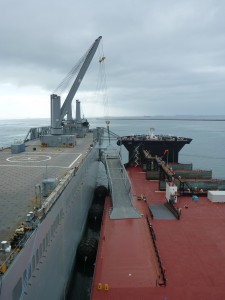
Clearly, what the Admiral has in mind is the role of MSC in sustaining the USN-USMC team in its littoral operations. “We have a fantastic amphibious warfare capability within our Navy. But these new classes of ship under construction (e.g., the Mobile Landing Platform) are going to be involved in operations that lean towards the littoral environment where amphibious warfare takes place.”
From the visit to the USS America and discusses with Captain Hall, it is clear that the USN anticipates MSC providing important support roles for the 21st century concept of an amphibious task force.
For example, the USS America has no well deck for launching amphibious vehicles but the MLP will be able to do so in a significant way.
And recent testing of a pairing of a the USNS Montford Point with a Large, Medium-Speed Roll-on/Roll-off (LMSR) demonstrated such a capacity.
On June 18, 2014, the USNS Montford Point and the USNS Bob Hope remained alongside with 16 mooring lines in a skin to skin configuration at anchor, overnight and during operations for a total of 36 hours to transfer and deliver to sea vehicles and LCACs.
Such at sea constant MSC fleet advancement of synergistic innovative replenishment efforts highlight a central proposition which the Admiral discussed with us.
We don’t have enough amphibious warfare ships to operate forward in the way we would like to.
The operational tempo and pace of our amphibious force is quite high.
I think we’re in a position where we have to look for creative and alternative uses of Military Sealift Command assets.
He underscored that the CNO focused on the requirement for the USN-USMC team to fight forward, and clearly with the shortfall in amphibious ships, the support role for MSC is going up.
Another key challenge is to meet the logistics demands of the disaggregated amphibious ready group which has been enabled by Osprey reach, speed and range, but which means the ships are further apart and need to be sustained as such.
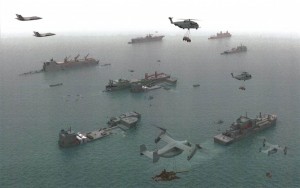
In addition to the MLP, the Admiral highlighted the roles of the T-AKE ships and the JHSV. The T-AKE ships are rapidly becoming the workhorses for the MSC and given the price point on the vessels of around $500 million per ship represent great value for the fleet.
And with the demonstration of an ability for the Osprey to land on the T-AKE ships in Bold Alligator 2012, the possibility of an expanded pairing between Osprey and T-AKE might be on offer even as a emergency divert lily pad if needed.
The Admiral noted: “If we make the hangar door four feet wider and make it two feet higher on the T-AKE, you can store an Osprey in there, so that you could then have one in the hangar and one on the deck of a T-AKE ship.”
The pace and tempo of USN fleet ops at a time of hull shorfalls highlights the key role for the MSC.
As the Admiral noted:
I think one thing where we help out a lot is, it seems like we have to be in many different places right now.
For example, we might have to be off of the coast of Libya perhaps, or the coast of Somalia perhaps, or elsewhere in Africa dealing with a HA/DR mission.
The hulls we’re bringing to the show, whether it’s TAKEs, MLPs, the follow-on dual afloat forward staging bases, and the 10 joint high-speed vessels, I think we really complement our amphibious warfare ships, especially when they have to split apart for operations and presence.
We asked the Admiral about the recent movement of the Bush to be able to support national options with regard to Iraq and how that affected MSC.
The Admiral commented: “when I saw the Bush start to move I called my Commodore in the region “How are you postured?” and he said, “I have the assets I need.”
We published earlier a piece on the Bush and noted that it was “ready on arrival.” Obviously, there is an MSC equivalent, for reach is really about sustainable reach and presence.
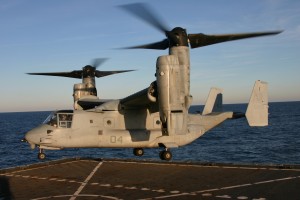
There is a key allied component to the MSC role as well which is often not highlighted. When we visited the first T-AKE ship to land an Osprey, the captain highlighted the allied role, which his ship had played in Odyssey Dawn.
According to Captain Little: “I would have to look up the exact statistics, but during our last deployment we provided underway replenishment to 70 different navy ships, including allied ships involved in Operation Odyssey Dawn. I believe we provided underway replenishment to about 20 different NATO ships during the Operation.”
The Admiral highlighted the mutual support role, which allies are providing.
The US has discussions and agreements with Asian allies, Canada, and the UK to provide mutual support under specific circumstances, so that South Korea, and Japan for example might provide tanking support to the fleet.
As Japan had done earlier by putting their oilier on station in the Indian Ocean during Operation Enduring Freedom.
The Admiral when commanding Carrier Strike Group One had refueled from the Japanese ship and was very complementary on the Japanese at sea nautical skills.
Canada is in extremis because of the age and condition of its tankers, and discussions are under way for the US to help Canada bridge its transition until new tankers are available to the Canadian navy.
We are about to sign an agreement with them, where we will provide them with some licensed engineers to participate in operating their ships.
The Protector on the West Coast, and the Preserver on the East Coast are both 40+ years old.
They just had a terrible fire on the Protector. In fact, we participated in towing that back to British Columbia for them.
We are engaged with dialog right now. The Canadian Navy has approached our Navy about providing them some supplemental capabilities.
A key part of the discussion focused on re-thinking how the MSC fleet operates with the USN-USMC in working an end-to-end supply chain from land to sea and back again.
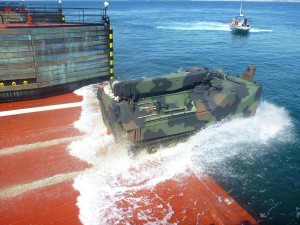
A key element in being forward deployed is to have as high an ops tempo as possible. This depends upon understanding how to deliver parts to the point of need in support of ongoing operations.
This requires shaping IT systems and operational reach for sustained logistical support.
It is what we do from the ships on the ocean that matters. Focus upon improving the flow of supplies from those ships operating globally is a key focus of attention for us.
We are working much more closely with USMC logisticians to figure out how to better integrate their needs with our capacity to have the right supplies on board to meet those needs.
For example, if an LCAC breaks down on a mobile landing platform, wouldn’t it be cool if the high-usage parts for repair were right there or within easy reach?
And the ability to manage the fleet from an end-to-end supply chain was a work in progress. An example of new ways ahead was suggested by the Admiral with regard to the Joint High Speed Vessel and how to manage loading operations.
Recently the Spearhead was operating in an exercise in Latin America.
The ship came pier side to take on a load.
The loadmaster was then faced with the challenge of fitting the load into the ship with regard to weight and balance to ensure effective operations.
Why not do like they do in the commercial shipping industry with regard to container ships and prepare a stability load plan before hand and send it electronically for the loadmaster to use as an aide to his effort.
We need to look at a virtual capability, much like the commercial container ship market. They know what’s in every box around the planet.
Our experience on MSC ships has certainly reinforced the quality of the mariners on board.
The Admiral throughout the interview drove this point home repeatedly. For example, the Admiral noted that he was recently on a T-AKE ship where the Chief Engineer had been at sea for 35 years and as Chief Engineer for 24 of those 35 years.
And the operational tempo of the fleet is possible only because of the significant at sea time of the civilian mariners who operate MSC ships.
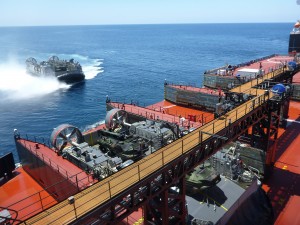
A final topic was the lingering concerns with the tanker fleet. The US has had to obtain a grandfather clause to operate its tanker fleet, which is almost solely made up of that dinosaur of oil tankers, the single hull tanker.
Indeed, the Admiral noted that recently MSC was denied port entry because of the single hull tanker.
It remains a mystery to us why building a double hull tanker fleet in an age of growing environmental sensitiveness and hi fleet ops tempo is not a priority.
In short, the Admiral provided a clear sense of the way ahead for the MSC and certainly reinforced the notion that MSC had moved from the back to the front of enabling the USN-USMC team for 21st century operations.
For earlier MSC and MSC related articles see the following:
https://sldinfo.com/interview-with-the-cno/
https://sldinfo.com/admiral-buzby-on-the-evolving-capabilities-of-a-usn-usmc-msc-enabled-fleet/
https://sldinfo.com/anticipating-the-usns-montford-point-an-interview-with-admiral-buzby/
https://sldinfo.com/military-sealift-command-builds-for-the-future/
https://sldinfo.com/building-a-new-ship-fred-harris-discusses-the-mobile-landing-platform/
https://sldinfo.com/the-seabase-in-evolution-the-navys-new-mobile-landing-platform/
https://sldinfo.com/the-christening-of-the-usns-montford-point/
https://sldinfo.com/replenishment-oiler-in-at-sea-operation/
https://sldinfo.com/t-ake-ship-at-sea-replenishment-operation/
https://sldinfo.com/preparing-for-bold-alligator-2013-shaping-the-future-of-distributed-operations/

